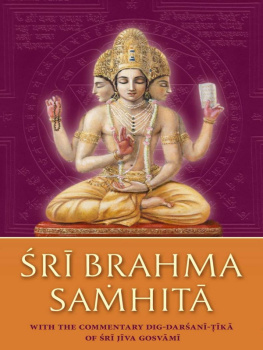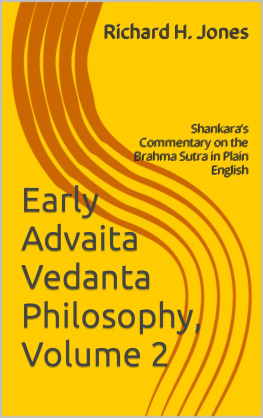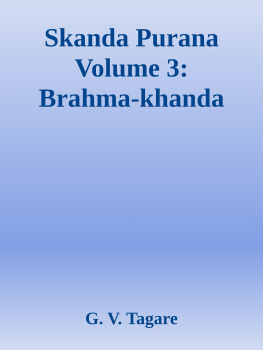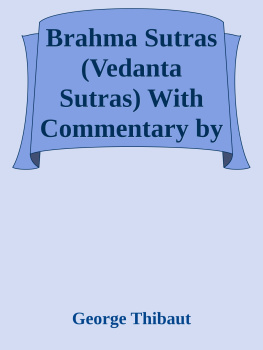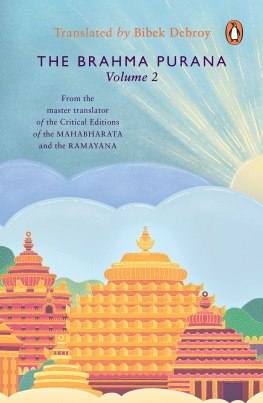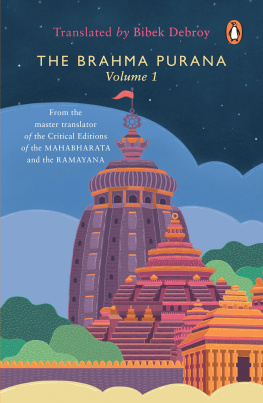r Brahma-sahit
with the Dig-daran-k
of Jva Gosvm
Translated by
Bhanu Swami
To find other ebooks of interest, visit bbtmedia.com.
Readers interested in the subject matter of this book are invited by the International Society for Krishna Consciousness to visit an ISKCON center. Addresses and phone numbers for those centers can be obtained at directory.krishna.com or by writing to the addresses listed below.
ISKCON Reader Services
P.O. Box 730, Watford, WD25 8ZE, United Kingdom
Tel. +44 (0)1923 857244
iskconuk.com
krishnawisdom.com
BBT Africa
84 Tennyson Road, Lombardy East
2090, Johannesburg, South Africa
bbtafrica.co.za
International Society for Krishna Consciousness
P.O. Box 34074, Los Angeles, CA 90034, USA
Tel. +1-800-927-4152, Fax +1-310-837-1056
harekrishna.com
To correspond directly with the author:
His Holiness Bhanu Swami
Hare Krishna Land, Injambakkam
Chennai, 600 041, India
Text 2008 Sri Vaikuntha Enterprises
All quotations from the books of His Divine Grace A.C. Bhaktivedanta SwamiPrabhupda The Bhaktivedanta Book Trust
www.krishna.com
www.bbt.se
First e-book edition: February 2013
ISBN 978-91-7149-710-9
This book is dedicated to His Divine Grace A. C. Bhaktivedanta Swami Prabhupda, who inspired the world to take up the path of bhakti.
I gratefully acknowledge His Grace rdhara yma Dsa for his assistance in editing this work.
Contents
Introduction
The Brahma-sahit is a work often quoted by Gauya cryas. The fifth chapter of this work was discovered by Lord Caitanya while he was traveling as a sannys in the di-keava temple in South India, as described in r Caitanya-caritmta, Madhya-ll 9.237. When the Lord found this work, tears came to His eyes, He began to tremble and perspire, and His hairs stood on end in ecstasy. He considered the Brahma-sahit an expression of the conclusion of all Vaiava scriptures, and had a copy of it made and brought to Pur.
Since then, the Brahma-sahit has been revered among Gauyas. Like rmad-Bhgavatam, it repesents Ka as svaya-bhagavn and shows His relationship to the forms of Viu, iva, Durg, Gaea, and Brahm. Though the whole of the Brahma-sahit has never been located, the fifth chapter stands alone as a short but complete work. It is by and large straightforward, but Jva Gosvm has written a commentary to clarify the ambiguous points.
r Brahma-sahit
TEXT 1
vara parama ka
sac-cid-nanda-vigraha
andir dir govinda
sarva-kraa-kraam
TRANSLATION
Ka is the supreme controller. He is the enjoyer of innumerable consorts and the possessor of an eternal form of knowledge and bliss. Though He is without origin, He is the source of all other forms of God and is the cause of all causes. He is Govinda, the boy who cares for the cows.
COMMENTARY
Rpa Gosvm, whose younger brother was r-vallabha and whose older brother is Santana Gosvm, is my good fortune. Indeed, he is the good fortune of all living entities.
May the excellence of Kas form be honored in my heart! It is by Kas mercy that I desire to explain the Brahma-sahit.
This work, passed down by the sages, though difficult to understand, is, on careful consideration, filled with meaning. In considering the proper meaning of this work, I take shelter of the greatest sage among sages, Vedavysa.
Though the Brahma-sahit has a hundred chapters, this fifth chapter is complete in itself because it succinctly expresses the essential meaning of all the scriptures. What persons of pure intelligence realize in the rmad-Bhgavatam and other works is present here. What I have explained extensively in Ka-sandarbha, I have reviewed, and some of those points I have used to explain the Brahma-sahit. Thus my heart is full of joy.
The Word Ka
The Bhgavatam verse (1.3.28) that begins ete ca-kal pusa kas tu bhagavn svayam establishes Ka as the primary form of Bhagavn. The same is stated in vara parama ka in the first verse of the Brahma-sahit. The word ka denotes a specific form of the Lord, whose name is Ka. This same form is denoted by great devotees such as ukadeva Gosvm in verses like the following:
sa vismayotphulla-vilocano hari
suta vilokynakadundubhis tad
kvatrotsava-sambhramo span
mud dvijebhyo yutam pluto gavm
When Vasudeva saw his extraordinary son, his eyes were struck with wonder. In transcendental jubilation, he mentally collected ten thousand cows and distributed them among the brhmaas as a transcendental festival for the appearance of Ka. (Bhgavatam 10.3.11)
The same form of the Lord is denoted in the Chndogya Upaniad of the Sma Veda in the words, kya vsudevya devak-nandanya: Unto Ka, Vsudeva, the son of Devak.
Placing the word ka first in a series of names of the Lord in this verse from the Chndogya Upaniad also indicates the supreme position of Kas name. Garga Muni indicates the same in the Bhgavatam (10.8.1314) by mentioning the name of Ka before the name of Vsudeva:
san vars trayo hy asya
ghato nuyuga tan
uklo raktas tath pta
idn kat gata
prg aya vasudevasya
kvacij jtas tavtmaja
vsudeva iti rmn
abhij sampracakate
Your son Ka appears as an incarnation in every millennium. In the past, He assumed three different colors white, red, and yellow and now He has appeared in a blackish color. For many reasons, this beautiful son of yours sometimes appeared previously as the son of Vasudeva. Therefore, those who are learned sometimes call this child Vsudeva.
The Brahma-sahit begins with the words vara parama ka to indicate, at the outset, that Ka is the principal form of God. This is similar to filling a pot with milk before using it for anything else, thus putting the pot to the best use first. That Kas name is the chief name of the Lord is also stated by the Lord in the Prabhsa-khaa of the Padma Pura in the conversation between Nrada and Kuadvaja:
nmn mukhyatama nma
kkhya me paran-tapa
O conquerer of enemies, my name Ka is the chief among all names.
Similarly, in the 108 names of the Lord mentioned in the Brahma Pura, it is said:
sahasra-nmn puyn
trir-vtty tu yat phalam
ekvtty tu kasya
nmaika tat prayacchati
The auspicious results obtained by reciting a thousand names of the Lord three times can be obtained by reciting the name of Ka once.
This statement of the Brahma Pura, that three thousand names of Viu are equal to one name of Ka, also applies to the name Govinda, mentioned in the Brahma-sahit (andir dir govinda and later, govindam di-puruatam aha bhajmi). Though the person indicated by the name Govinda is Ka, the name Govinda is used to indicate His special identity as a cowherd.
The other words in the verse, starting with the word vara, describe Kas unique nature, using the conventional meaning of the word ka, already denoted as the son of Nanda. The same singularity of Ka, the son of Nanda, is stated by Garga:
san vars trayo hy asya
ghato nuyuga tan
uklo raktas tath pta
idn kat gata
bahni santi nmni

